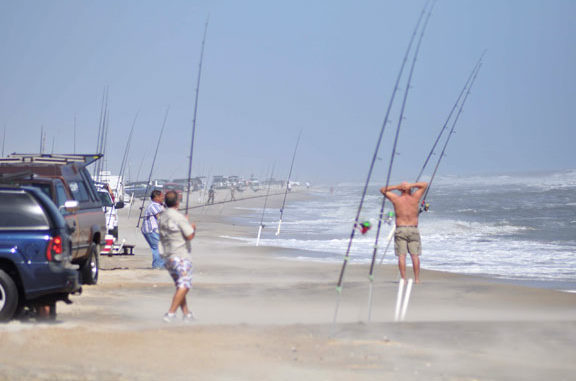
National Park Service restricts off-road-vehicle use on Outer Banks beaches.
The National Park Service announced on Jan. 23 its final rule for off-road beach driving and public beach access at Cape Hatteras National Seashore, and, as expected, it drew mixed reviews from Outer Banks residents, businesses and environmental groups.
“It’s a lot worse than the injunction (that set up interim beach-driving and public-access rules),” said Frank Folb, owner of Fran & Frank’s tackle store at Avon.
The Southern Law Environmental Center, which sued NPS in 2007 on behalf of The Audubon Society and Defenders of Wildlife and won more restrictive interim beach-driving and access rules, was elated with the decision.
“The park service’s rules are a compromise that provides protections for both pedestrians and wildlife while still allowing responsible beach driving,” said Julie Youngman, an SLEC attorney.
Click here to read more about the initial beach closures.
“With both the number of hatchlings and visitors to the beach climbing, the success of responsible beach management is clear,” said Jason Rylander, an attorney for Defenders of Wildlife. “The new rules will ensure that Cape Hatteras continues to provide enjoyment to beach users while protecting the unique wildlife that call the seashore home.”
Folb and others aren’t so optimistic about the upcoming results.
“(NPS) put in a beach-driving permit requirement,” he said. “Nobody knows, but we think (the cost will be) $50 for 10 days and $150 for a year.”
Folb pointed out the documents that founded CHNS declare the park will be open to the public for recreational uses and doesn’t mention user fees. The NPS hasn’t set quotas for ORV permits, but said each stretch of beach can have no more than 260 vehicles per mile, that vehicles can’t park closer than 20 feet from one another and must not form windbreaks or communal groups.
Rules for night driving were clarified to include language that portions of those beaches which are designated ORV routes may be opened for night driving from Sept. 15-Nov. 15 if no turtle nests remain in the area.
But ORV residents remain disappointed.
“This (ruling) will cost me 30 percent of my (annual) business,” said Folb, who sells fishing lures, tackle and bait to anglers who drive to inlets and popular hot spots such as Cape Point near Buxton, which will be closed if a threatened or endangered bird appears.
“If a bird breaks wind on the beach, (NPS) will close it down,” Folb said. “Twenty-six miles will be open (all the time) to ORVs, but none of the inlets (Oregon, Hatteras, Ocracoke) will be open. Ramp 34 (in Avon) will be closed year-round, and the beaches in front of the villages, instead of opening Sept. 15 and closing May 1, will reopen Nov. 1 and close March 31.”
Although the SELC said “the majority” of beaches would be open to ORV use, that statement is not precise. Twenty-seven miles of ORV beaches are eligible to be closed if a bird is spotted nesting or a turtle crawls ashore to lay eggs.
Opponents of the plan, including Folb, the Outer Banks Preservation Association and N.C. Beach Buggy Association, note the Park Service basically ignored comments that the science behind resource management and the NPS economic study contained flaws and often omitted needed information.
Less than a dozen shorebirds, notably piping plovers, successfully nest and fledge young birds each year at Cape Hatteras. The birds often nest on bare sand below the tide line at many popular fishing areas where storms routinely flood nests and wash them away
Environmentalists dispute the oppressive economic impact of restricted beach driving cited by opponents of the NPS plan.
Although the NPS received more than 21,000 letters, calls and e-mails from citizens and OBX businesses that took up 50 pages in the Federal Register announcement, the actual changes made to Alternative F, one of a handful of management options (and preferred by SELC), took up one page in the final published rule,
Although Mike Murray, the superintendent of CHNS, has had the flexibility to alter beach closures and ORV access routes that reflect changing conditions, the final NPS decision stripped him of that authority. Any alteration of the current plan he wishes to make must now undergo an Environmental Impact Study, which can take years to complete.
Let us know what you think about the decision by posting on our Inshore Fishing forum!
Not a member of the Sportsman team yet? It’s free! So register today to get started!

